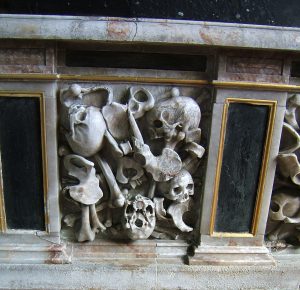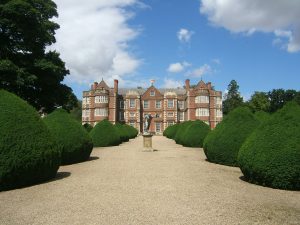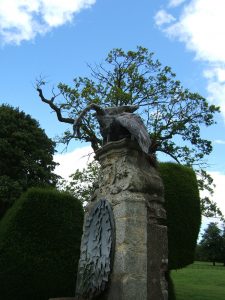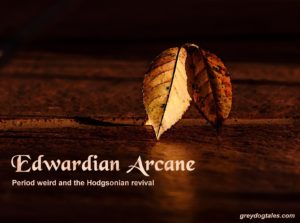A skull is a box in which we keep our memories. Except that only a few of us tie it up with ribbons, and it usually makes little noise. Until it becomes a screaming skull, of course. A few weeks ago we stood before a four hundred year old group portrait of three women, Frances, Margaret and Katherine Griffiths. The painting dominates its surroundings, and Katherine Griffiths dominates the painting. Unlike her sisters, her dress has been re-rendered in dead black, and her presence has never left her beloved home. Neither has her skull, except for brief and unhappy moments.

Today we explore a few different manifestations of the screaming skull, including the famous tale by F Marion Crawford, and generally potter about a bit, as we do. Before we do, have a quote from an account of an account of an account, to which we’ll return later below.
“…the skull was that of a negro servant who had lived in the service of a Roman Catholic priest, and there were dark hints of a murder. The negro had declared before his death that his spirit would not rest unless his body were taken to his native land and buried there. On his burial in the Bettiscombe churchyard, the haunting began; fearful screams proceeded from the grave; strange sounds were heard all over the house, and the inmates had no rest until the body was dug up. Subsequent attempts to dispose of it were followed by similar results.”
THE BURTON AGNES SCREAMING SKULL
Burton Agnes, the home of Katherine Griffiths (known as Anne), is a magnificent Elizabethan house in the Yorkshire Wolds. The present house was built nearby in 1601–10 by Sir Henry Griffith, 1st Baronet, after he was appointed to the Council of the North. His daughter Frances Griffith, heiress of the estate, married Sir Matthew Boynton, Governor of Scarborough Castle. It’s also one of the most well-known settings for a ‘screaming skull’ legend. As it lies within the uncanny Wold Newton Triangle, and thus directly within our ancestral hunting grounds, we have to mention it.
The story is that Anne had watched the building of the new house and could talk and think of nothing else; it was to be the most beautiful house ever built. When it was almost finished Anne went one afternoon to visit the St. Quintins at Harpham about a mile away, but near St. John’s Well was attacked and robbed by ruffians. She was brought home to Burton Agnes but was so badly hurt that she died a few days afterwards.
Sometimes delirious, sometimes sensible, she told her sisters that she would never rest unless part of her could remain in ‘our beautiful home as long as it shall last’. She made them promise that when she was dead her head should be severed and preserved in the Hall forever, and to pacify her, the sisters agreed. However when Anne died, she was buried in the churchyard.
Then the ghost walked and scared the life out of everybody. Remembering Anne’s dying words, the sisters took counsel with the vicar and eventually agreed that the grave should be opened. The skull was brought into the house and so long as it was undisturbed, the Hall was peaceful and untroubled. Many attempts have been made to get rid of it. Once it was thrown away, another time it was buried in the garden, but always the ghost walked with tremendous noise and upheaval. The skull is still in the house, built into one of the old walls, probably in the Great Hall. Nobody knows for sure just where it is but now she can watch over ‘her beautiful home’.
Burton Agnes Hall
In addition to the legend of Anne Griffiths, Burton Agnes Hall has grounds which include beautiful gardens, an interesting church, and substantial parts of a Norman manor house, built in 1173 by Roger de Stuteville.

Unusually, the site has been in the hands of the same family since that time, passing through various branches, and is still inhabited by the line.
Bettiscombe Manor
“Students of ghost lore and haunted houses will find the foundation of the foregoing story in the legends about a skull which is still preserved in the farmhouse called Bettiscombe Manor, situated, I believe, on the Dorsetshire coast.”
F Marion Crawford, footnote to ‘The Screaming Skull’
The other most commonly mentioned ‘real life’ example of the screaming skull is usually Bettiscombe Manor in Dorsetshire. We won’t bore you with the general outline – it’s more interesting to go back to our Edwardian Arcane theme, for there are two excellent related pieces for the curious reader and/or historian of the supernatural.
For the readers of scary tales, there is the story written by American writer F Marion Crawford (1854-1909), probably better known for his story ‘The Upper Berth’. ‘The Screaming Skull’ was written in 1908, and published posthumously in 1911, in the collection Uncanny Tales, also known as Wandering Ghosts.
Crawford’s version, although he states his inspiration as Bettiscombe Manor, concerns neither the type of haunting from Bettiscombe, nor that from Burton Agnes. Instead it involves a retired seaman, a history of domestic unrest by the previous occupants of his house, and one long evening where he addresses a fellow mariner who has come to stay with him. It seems rather extended at points, and yet at the same time it’s a slow builder. It has a clever notion in that the story, and the narrator’s standpoint, develop substantially during the relating of it. And it is a screaming skull, of sorts, though it has other tricks…

For historians of the supernatural and folklorists, we are fortunate in that there is a full account of an investigation made into the Bettiscombe screaming skull, published very shortly after Crawford died. The writer was an English fellow named John Symonds Udal (1848–1925).
Udal was a cricketer, antiquarian, author, lawyer and judge, and quite a chap. He held government office in Fiji for many years, and later served as Chief Justice of the Leeward Islands*. He wrote:
“At a farmhouse in Dorsetshire at the present time, is carefully preserved a human skull, which has been there for a period long antecedent to the present tenancy. The peculiar superstition attaching to it is that if it be brought out of the house the house itself would rock to its foundations, whilst the person by whom such an act of desecration was committed would certainly die within the year. It is strangely suggestive of the power of this superstition that through many changes of tenancy and furniture the skull still holds its accustomed place ” unmoved and unremoved! “
Proceedings of the Dorset Natural History & Archaeological Society Vol 31, 1910
* The Leeward Islands were Antigua, Barbuda, the British Virgin Islands, Montserrat, Saint Kitts, Nevis, Anguilla and Dominica.
In what might tip us into M R James territory, Udal studied Dorset folklore, customs, and traditions, and became a Fellow of the Society of Antiquaries of London in 1901. He would certainly have made a suitable MRJ protagonist.
And there is a curious Dorset and Leewards Islands link. During his time as Chief Justice, Udal was shown a memorial on Nevis to John Pinney, son of Azariah Pinney, formerly of Bettiscombe. On the basis of this, he concluded that the Bettiscombe Skull was that of one of Pinney’s slaves. Finding a reference in an old register of slaves on the Pinney estate to “Bettiscombe”, he concluded that the skull belonged to a slave named Bettiscombe, who must have been brought to England when or before the Nevis estates were sold.
Most entries then add that this theory, which Udal published in the Somerset and Dorset Notes and Queries, was disproved long after Udal’s death. However, what Udal said in his original account includes the following:
“Upon one of these subsequent visits I, with others, made a careful examination of the skull; and we were inclined to doubt whether it was that of a negro at all, but as the generally received opinion is that it is I will say no more upon that point. The skull was by no means a large one; the forehead certainly was low but not receding. The upper half of the cranium only was preserved, the lower jaw being missing.”
If Udal was persuaded, it was by weight of hearsay, local legend, and a fascination with the Pinney connection, as more than once in the records he states his doubts. Eventually, he burrows into a long examination of the question of Azariah Pinney, who appears to have been transported as a ‘white slave’ after the Monmouth Rebellion in 1685. Yes, it all gets very complicated, so we’d better leave it to the really curious. You can read the entire, detailed 1910 piece by Udal here:
http://archive.org/details/proceedings31dorsuoft/
NOTE: Crawford, in his fictitious version, avoids the slave angle, but retains certain elements, including the skull being kept in a hatbox, and the fact that the lower jaw was missing.
A Film at which to Scream
F Marion Crawford’s story was ‘sort of’ adapted for the screen – though the film never credited him. Probably best. The Screaming Skull is a 1958 black and white horror film, produced by John Kneubuhl, T. Frank Woods, and John Coots, directed by Alex Nicol, that stars John Hudson, Peggy Webber, Russ Conway, and Nicol.
It’s a bad movie, in that sort of way which means you can quite enjoy it, and it has moments of being creepily atmospheric. This is delightfully enhanced by the warning at the start. An opening voice-over states that a free burial will be provided to anybody who dies of fright while watching the film. This, we assure you, is not very likely.
In the film, there is a similarly domestic background to it all, with the skull supposedly being that of Marion, the first wife of John Hudson’s character. Yep, Marion. An unsubtle reference to the source of some of their ideas? So in the film you have:
- the first wife who died of an ‘accident’
- a wealthy second wife who has spent some time in an asylum
- a developmentally disabled gardener
- a self-portrait by Marion which resembles the 2nd wife’s mother?
- unexplained screaming noises
- an actual skull
And so much more. Technically, you might be better sticking to the original story, however.
Or, for more literary relaxation with a screaming skull, you can download the Wandering Ghosts collection by F Marion Crawford for free here:



